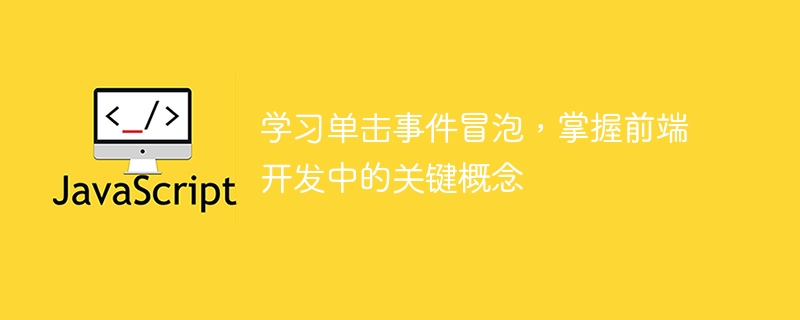

Learn click event bubbling and master key concepts in front-end development. Specific code examples are required
Front-end development is an important field in today's Internet era, and Event bubbling is one of the key concepts in front-end development. Understanding and mastering event bubbling is critical to writing efficient front-end code. This article will introduce what event bubbling is and how to use the concept of event bubbling in front-end development.
1. What is event bubbling
Event bubbling means that when an event on an element is triggered, it will start from the innermost element first, and then bubble up to the parent element step by step. , up to the top-level element. In other words, the event fires starting from the most specific element (such as a button) and then bubbles up along the parent element to the top-level element (such as the entire document).
For example, we have an HTML structure as follows:
<div id="parent">
<div id="child">
<button id="button">点击我</button>
</div>
</div>We add a click event to the button and use JavaScript code to listen to the event:
var button = document.getElementById('button');
button.addEventListener('click', function() {
console.log('按钮被点击了');
});When we click the button When, the console will output 'The button was clicked'. This is because event bubbling causes the click event to bubble up from the button, all the way up the DOM tree to the top-most element.
2. How to use event bubbling
First, we need to understand how to prevent event bubbling. Sometimes, an event we register on an element may trigger the same event on the element's parent element. To prevent this from happening, we can use the stopPropagation() method in JavaScript to stop the event from bubbling up.
var child = document.getElementById('child');
child.addEventListener('click', function(event) {
console.log('子元素被点击了');
event.stopPropagation(); // 阻止事件冒泡
});In the above example, when we click on the child element, only 'The child element was clicked' will be output, and the click event on the parent element will not be triggered.
In addition to stopping event bubbling, we can also use event bubbling to delegate event processing. Delegating event handling is a common way to optimize front-end code. It can reduce the number of event registrations and improve page performance.
Suppose we have a list, and the number of list items may be very large. If we register a click event for each list item, when there are many list items, it will cause a lot of event registration and memory usage. At this time, we can delegate the event to the parent element and handle the click event through event bubbling.
<ul id="list"> <li>列表项1</li> <li>列表项2</li> <li>列表项3</li> <li>列表项4</li> <!-- 更多列表项省略 --> </ul>
var list = document.getElementById('list');
list.addEventListener('click', function(event) {
if (event.target.tagName === 'LI') {
console.log(event.target.innerHTML);
}
});Through delegated event processing, we only register a click event on the parent element to handle clicks on all child elements. When we click on a list item, the console will output the contents of the corresponding list item.
In the above code, we use the event.target property to get the element that triggered the event. Then, by judging whether the tag name of the element is 'LI', we determine whether it is the list item we want to process. This implements the processing of click events for all list items.
By understanding and mastering the concept of event bubbling, we can handle events in front-end development more flexibly and efficiently. At the same time, by properly using event bubbling, we can optimize the front-end code and improve page performance.
Summary: This article introduces what event bubbling is and how to use the concept of event bubbling in front-end development. We learned how to stop events from bubbling up and how to optimize front-end code by delegating event handling. Through specific code examples, we have mastered these key concepts and hope to be helpful to readers in front-end development.
The above is the detailed content of Explore click event bubbling and master the key principles of front-end development. For more information, please follow other related articles on the PHP Chinese website!